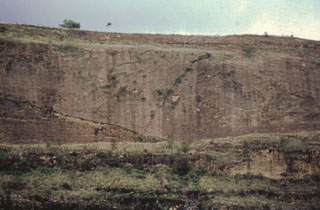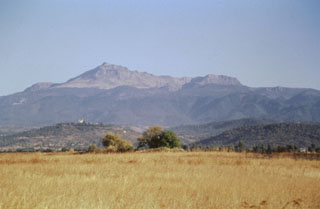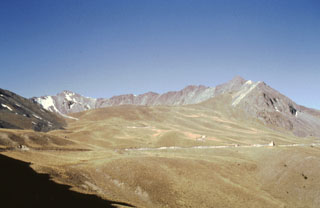

The Global Volcanism Program has no activity reports available for Nevado de Toluca.
The Global Volcanism Program has no Weekly Reports available for Nevado de Toluca.
The Global Volcanism Program has no Bulletin Reports available for Nevado de Toluca.
|
|
||||||||||||||||||||||||||||
There is data available for 1 confirmed eruptive period.
1350 BCE (?) Confirmed Eruption (Explosive / Effusive)
| Episode 1 | Eruption (Explosive / Effusive) | |||||||||||||||||||||||||||||
|---|---|---|---|---|---|---|---|---|---|---|---|---|---|---|---|---|---|---|---|---|---|---|---|---|---|---|---|---|---|
| 1350 BCE (?) - Unknown | Evidence from Isotopic: 14C (uncalibrated) | ||||||||||||||||||||||||||||
|
List of 4 Events for Episode 1
|
|||||||||||||||||||||||||||||
This compilation of synonyms and subsidiary features may not be comprehensive. Features are organized into four major categories: Cones, Craters, Domes, and Thermal Features. Synonyms of features appear indented below the primary name. In some cases additional feature type, elevation, or location details are provided.
Synonyms |
||||
| Xinantécatl | ||||
Domes |
||||
| Feature Name | Feature Type | Elevation | Latitude | Longitude |
| Aguila, Pico del | Dome | |||
| Fraile, Pico del | Dome | 4690 m | ||
| Gordo, Cerro | Dome | |||
| Ombligo, El | Dome | |||
| Preito, Cerro | Dome | |||
 Nevado de Toluca is seen here from the NW. It is a broad, complex stratovolcano with a 1.5-km-wide summit crater that opens to the east. A lava dome in this crater separates two lakes, known as the lakes of the Sun and Moon, which can be reached by the road seen ascending diagonally across the snow-covered slopes.
Nevado de Toluca is seen here from the NW. It is a broad, complex stratovolcano with a 1.5-km-wide summit crater that opens to the east. A lava dome in this crater separates two lakes, known as the lakes of the Sun and Moon, which can be reached by the road seen ascending diagonally across the snow-covered slopes. Stream erosion exposes an outcrop of the Upper Toluca Pumice, which originated during the last large Plinian eruption of Nevado de Toluca volcano some 10,500 years ago. This eruption produced a sequence of pyroclastic flow, pyroclastic surge, and ashfall deposits. Note the person at the top of the outcrop for scale. The Upper Toluca Pumice was distributed primarily to the NE and is found over much of the Valley of México.
Stream erosion exposes an outcrop of the Upper Toluca Pumice, which originated during the last large Plinian eruption of Nevado de Toluca volcano some 10,500 years ago. This eruption produced a sequence of pyroclastic flow, pyroclastic surge, and ashfall deposits. Note the person at the top of the outcrop for scale. The Upper Toluca Pumice was distributed primarily to the NE and is found over much of the Valley of México. The upper flanks of the dominantly Pleistocene Nevado de Toluca volcano consist primarily of lava flows that are well exposed above the tree line. This view shows the western flanks of Pico del Fraile, the high point on the SW rim of the horseshoe-shaped summit crater. The summit crater and flanks have been extensively modified by glacial erosion.
The upper flanks of the dominantly Pleistocene Nevado de Toluca volcano consist primarily of lava flows that are well exposed above the tree line. This view shows the western flanks of Pico del Fraile, the high point on the SW rim of the horseshoe-shaped summit crater. The summit crater and flanks have been extensively modified by glacial erosion. The rounded El Ombligo dome is one of the youngest features in the summit crater of Nevado de Toluca. The dome separates the crater floor into two lakes, the largest of which on the SW side of the crater (left) is called Lake of the Sun. The other lake, known as the Lake of the Moon, lies beyond the right side of the dome in this view, which shows the road leading into the summit crater to the right.
The rounded El Ombligo dome is one of the youngest features in the summit crater of Nevado de Toluca. The dome separates the crater floor into two lakes, the largest of which on the SW side of the crater (left) is called Lake of the Sun. The other lake, known as the Lake of the Moon, lies beyond the right side of the dome in this view, which shows the road leading into the summit crater to the right.  Nevado de Toluca is seen here from the south with its highest peak El Fraile to the left. The volcano is also known by its Nahuatl name, Xinantécatl. The morphology is due in part to explosive eruptions, large slope failures, and glacial erosion. Nevado de Toluca lies 80 km WSW of Mexico City.
Nevado de Toluca is seen here from the south with its highest peak El Fraile to the left. The volcano is also known by its Nahuatl name, Xinantécatl. The morphology is due in part to explosive eruptions, large slope failures, and glacial erosion. Nevado de Toluca lies 80 km WSW of Mexico City. The horseshoe-shaped summit crater of Toluca beyond the east-flank town of San Antonio Balderas opens towards the east. Block-and-ash flows from late-Pleistocene eruptions about 40,000 and 28,000 years ago cover this and other flanks of the volcano over an area of 630 km2.
The horseshoe-shaped summit crater of Toluca beyond the east-flank town of San Antonio Balderas opens towards the east. Block-and-ash flows from late-Pleistocene eruptions about 40,000 and 28,000 years ago cover this and other flanks of the volcano over an area of 630 km2. An exposure on the south flank of the Nevado de Toluca shows two debris flow deposits transformed from original flank failures of the volcano during the late Pleistocene. Debris avalanche and lahar deposits cover a broad area of about 500 km2 to the south.
An exposure on the south flank of the Nevado de Toluca shows two debris flow deposits transformed from original flank failures of the volcano during the late Pleistocene. Debris avalanche and lahar deposits cover a broad area of about 500 km2 to the south. The southern flanks of Nevado de Toluca are seen here from near the town of Coatepec, with the summit peak of El Fraile to the left. The photo clearly shows the tree line on Toluca at about 4,000 m. Massive block-and-ash flows about 37,000 and 28,000 years ago extended down the southern flanks and beyond Coatepec. The hills in the foreground represent semi-vertical faces of faults forming a complex set of horst and graben structures.
The southern flanks of Nevado de Toluca are seen here from near the town of Coatepec, with the summit peak of El Fraile to the left. The photo clearly shows the tree line on Toluca at about 4,000 m. Massive block-and-ash flows about 37,000 and 28,000 years ago extended down the southern flanks and beyond Coatepec. The hills in the foreground represent semi-vertical faces of faults forming a complex set of horst and graben structures. Nevado de Toluca is a broad edifice with a 1.5-km-wide summit crater that opens to the east. The northern flank rises here above the Zacango valley with a thin covering of summit snow. Two explosive eruptions during the late Pleistocene produced widespread ashfall and pyroclastic flow deposits. More recent work has revealed evidence for at least one Holocene eruption, about 3,300 years ago.
Nevado de Toluca is a broad edifice with a 1.5-km-wide summit crater that opens to the east. The northern flank rises here above the Zacango valley with a thin covering of summit snow. Two explosive eruptions during the late Pleistocene produced widespread ashfall and pyroclastic flow deposits. More recent work has revealed evidence for at least one Holocene eruption, about 3,300 years ago. The far western crater rim of Nevado de Toluca volcano is seen here on the horizon from the NE. The road into the crater is across the center of the photo below the low, smoother northern crater rim. The smooth surface of the northern flank consists of a lava flow that was modified by extensive Pleistocene-Holocene glacial erosion.
The far western crater rim of Nevado de Toluca volcano is seen here on the horizon from the NE. The road into the crater is across the center of the photo below the low, smoother northern crater rim. The smooth surface of the northern flank consists of a lava flow that was modified by extensive Pleistocene-Holocene glacial erosion.  Cones of the Chichinautzin volcanic field in the foreground and middle distance are seen here looking to the west from Popocatépetl volcano. The large flat-topped volcano on the far horizon is Nevado de Toluca. The broad Chichinautzin volcanic field covers a 90-km-wide area south of the Valley of Mexico between the base of the Sierra Nevada (containing Popocatépetl and Iztaccíhuatl) and the eastern flank of Nevado de Toluca.
Cones of the Chichinautzin volcanic field in the foreground and middle distance are seen here looking to the west from Popocatépetl volcano. The large flat-topped volcano on the far horizon is Nevado de Toluca. The broad Chichinautzin volcanic field covers a 90-km-wide area south of the Valley of Mexico between the base of the Sierra Nevada (containing Popocatépetl and Iztaccíhuatl) and the eastern flank of Nevado de Toluca. Nevado de Toluca is seen here from the NW just after a winter snowfall. The Pico del Fraile summit is to the right. Late-Pleistocene block-and-ash flows and Plinian eruptions have affected all sides of the volcano.
Nevado de Toluca is seen here from the NW just after a winter snowfall. The Pico del Fraile summit is to the right. Late-Pleistocene block-and-ash flows and Plinian eruptions have affected all sides of the volcano.The following 2 samples associated with this volcano can be found in the Smithsonian's NMNH Department of Mineral Sciences collections, and may be availble for research (contact the Rock and Ore Collections Manager). Catalog number links will open a window with more information.
| Catalog Number | Sample Description | Lava Source | Collection Date |
|---|---|---|---|
| NMNH 117276-3 | Pumice | -- | -- |
| NMNH 117276-4 | Pumice | -- | -- |
| Copernicus Browser | The Copernicus Browser replaced the Sentinel Hub Playground browser in 2023, to provide access to Earth observation archives from the Copernicus Data Space Ecosystem, the main distribution platform for data from the EU Copernicus missions. |
| MIROVA | Middle InfraRed Observation of Volcanic Activity (MIROVA) is a near real time volcanic hot-spot detection system based on the analysis of MODIS (Moderate Resolution Imaging Spectroradiometer) data. In particular, MIROVA uses the Middle InfraRed Radiation (MIR), measured over target volcanoes, in order to detect, locate and measure the heat radiation sourced from volcanic activity. |
| MODVOLC Thermal Alerts | Using infrared satellite Moderate Resolution Imaging Spectroradiometer (MODIS) data, scientists at the Hawai'i Institute of Geophysics and Planetology, University of Hawai'i, developed an automated system called MODVOLC to map thermal hot-spots in near real time. For each MODIS image, the algorithm automatically scans each 1 km pixel within it to check for high-temperature hot-spots. When one is found the date, time, location, and intensity are recorded. MODIS looks at every square km of the Earth every 48 hours, once during the day and once during the night, and the presence of two MODIS sensors in space allows at least four hot-spot observations every two days. Each day updated global maps are compiled to display the locations of all hot spots detected in the previous 24 hours. There is a drop-down list with volcano names which allow users to 'zoom-in' and examine the distribution of hot-spots at a variety of spatial scales. |
|
WOVOdat
Single Volcano View Temporal Evolution of Unrest Side by Side Volcanoes |
WOVOdat is a database of volcanic unrest; instrumentally and visually recorded changes in seismicity, ground deformation, gas emission, and other parameters from their normal baselines. It is sponsored by the World Organization of Volcano Observatories (WOVO) and presently hosted at the Earth Observatory of Singapore.
GVMID Data on Volcano Monitoring Infrastructure The Global Volcano Monitoring Infrastructure Database GVMID, is aimed at documenting and improving capabilities of volcano monitoring from the ground and space. GVMID should provide a snapshot and baseline view of the techniques and instrumentation that are in place at various volcanoes, which can be use by volcano observatories as reference to setup new monitoring system or improving networks at a specific volcano. These data will allow identification of what monitoring gaps exist, which can be then targeted by remote sensing infrastructure and future instrument deployments. |
| Volcanic Hazard Maps | The IAVCEI Commission on Volcanic Hazards and Risk has a Volcanic Hazard Maps database designed to serve as a resource for hazard mappers (or other interested parties) to explore how common issues in hazard map development have been addressed at different volcanoes, in different countries, for different hazards, and for different intended audiences. In addition to the comprehensive, searchable Volcanic Hazard Maps Database, this website contains information about diversity of volcanic hazard maps, illustrated using examples from the database. This site is for educational purposes related to volcanic hazard maps. Hazard maps found on this website should not be used for emergency purposes. For the most recent, official hazard map for a particular volcano, please seek out the proper institutional authorities on the matter. |
| IRIS seismic stations/networks | Incorporated Research Institutions for Seismology (IRIS) Data Services map showing the location of seismic stations from all available networks (permanent or temporary) within a radius of 0.18° (about 20 km at mid-latitudes) from the given location of Nevado de Toluca. Users can customize a variety of filters and options in the left panel. Note that if there are no stations are known the map will default to show the entire world with a "No data matched request" error notice. |
| UNAVCO GPS/GNSS stations | Geodetic Data Services map from UNAVCO showing the location of GPS/GNSS stations from all available networks (permanent or temporary) within a radius of 20 km from the given location of Nevado de Toluca. Users can customize the data search based on station or network names, location, and time window. Requires Adobe Flash Player. |
| DECADE Data | The DECADE portal, still in the developmental stage, serves as an example of the proposed interoperability between The Smithsonian Institution's Global Volcanism Program, the Mapping Gas Emissions (MaGa) Database, and the EarthChem Geochemical Portal. The Deep Earth Carbon Degassing (DECADE) initiative seeks to use new and established technologies to determine accurate global fluxes of volcanic CO2 to the atmosphere, but installing CO2 monitoring networks on 20 of the world's 150 most actively degassing volcanoes. The group uses related laboratory-based studies (direct gas sampling and analysis, melt inclusions) to provide new data for direct degassing of deep earth carbon to the atmosphere. |
| Large Eruptions of Nevado de Toluca | Information about large Quaternary eruptions (VEI >= 4) is cataloged in the Large Magnitude Explosive Volcanic Eruptions (LaMEVE) database of the Volcano Global Risk Identification and Analysis Project (VOGRIPA). |
| EarthChem | EarthChem develops and maintains databases, software, and services that support the preservation, discovery, access and analysis of geochemical data, and facilitate their integration with the broad array of other available earth science parameters. EarthChem is operated by a joint team of disciplinary scientists, data scientists, data managers and information technology developers who are part of the NSF-funded data facility Integrated Earth Data Applications (IEDA). IEDA is a collaborative effort of EarthChem and the Marine Geoscience Data System (MGDS). |